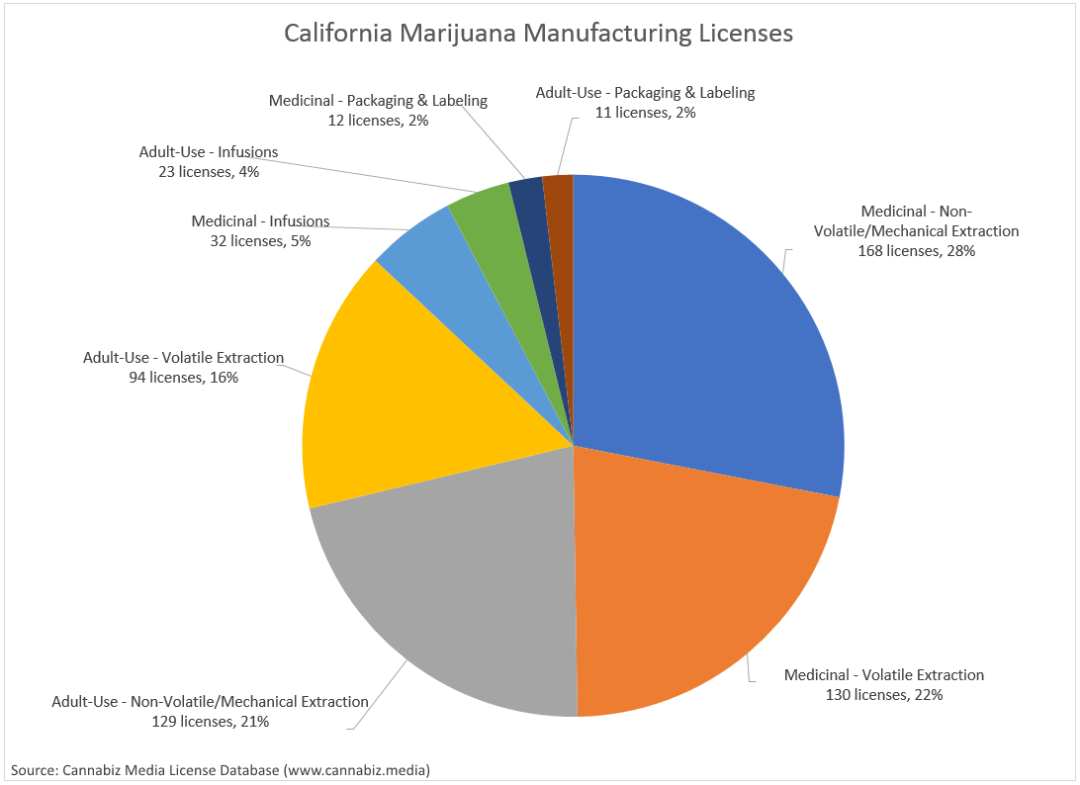Marijuana Licenses in California – Part 3
Guest post by Ed Keating, Co-Founder and Chief Data Officer at Cannabiz Media
Part 3 in Cannabiz Media’s 6-part series about marijuana licenses in California, examines the state’s manufacturing licenses. If you missed previous parts of the series, you can follow the links to read them now: Part 1: California Overview and Part 2: California Cultivation.
California’s Marijuana Manufacturing Licenses
The Manufactured Cannabis Safety Branch (MCSB) of the California Department of Health is responsible for licensing marijuana manufacturers in the state. The MCSB offers four types of licenses for cannabis manufacturers:
- Extraction using a volatile solvent such as butane, propane, or hexane
- Extraction using a mechanical method or non-volatile solvent such as CO2, ethanol, water, or food-grade dry ice, cooking oils, or butter
- Infusions
- Packaging and labeling only
According to the Cannabiz Media Database, there are currently 521 extraction licenses, 55 infusion licenses, and 23 packaging licenses in California, which are broken down between 342 medicinal licenses and 257 adult-use licenses. The chart below shows the more specific breakdown between the four license types listed above as well as medical versus adult-use licenses.

Where are California’s Marijuana Manufacturing Licenses?
In total, marijuana manufacturing licenses are in 28 of the state’s 58 counties, but two out of three marijuana manufacturing licenses in California (66%) are in just five of the state’s 58 counties: Alameda (19%), Los Angeles (15%), Riverside (14%), Humboldt (10%), and Monterey (7%).
Expanding that a bit, 90% of California’s marijuana manufacturing licenses are in just 12 of the state’s 58 counties: Alameda, Los Angeles, Riverside, Humboldt, Monterey, Santa Cruz (6%), San Bernardino (4%), Sacramento (3%), Sonoma (3%), San Francisco (3%), San Diego (3%), and Santa Clara (3%).
Looking at license concentration within cities, half of all marijuana manufacturing licenses in California (51%) are in only 10 cities. Oakland ranks highest at 97 licenses, which is more than 3-times as many manufacturing licenses as the next highest ranking city, Cathedral City, which has 32 licenses.
The 10 cities where half of California’s marijuana manufacturing licenses are concentrated are: Oakland (16%), Cathedral City (5%), Arcata (5%), Desert Hot Springs (5%), Adelanto (4%), Los Angeles (4%), Lynwood (4%), Sacramento (3%), Coachella (3%), and San Francisco (3%).
The geographical concentration of volatile extraction licenses is a bit different than the concentration of marijuana manufacturing licenses overall, which can be attributed to the fact that some communities don’t want this type of manufacturing facility in their backyards. In total, volatile extraction licenses can be found in 14 counties and more than half (56%) are in only three counties: Los Angeles (31%), Santa Cruz (15%), and Humboldt (11%).
Who Has the Manufacturing Licenses in California?
Unlike California’s marijuana cultivation licenses where a small number of companies have a large number of licenses, there are no clear dominant players in marijuana manufacturing based on current license distribution. The 599 manufacturing licenses in California are held by 351 license holders. Only 113 marijuana manufacturing license holders have just one manufacturing license while 446 manufacturing license holders have two or more manufacturing licenses.
Of license holders who have more than one manufacturing license, four have four licenses, two have three licenses, and 232 have two licenses. License holders with multiple licenses typically hold a strategic pair of licenses. For example, a license holder with an Adult Use Infusions licenses would also have a Medicinal Use Infusions license.
When it comes to marijuana manufacturing, most license holders are limited by their size and capacity, not by acreage as cultivation license holders are. Therefore, there is no real need to hold a lot of licenses. Instead, manufacturers seek to obtain licenses for adult use and medicinal use in the manufacturing areas they specialize in.
Coming up Next in the Marijuana Licenses in California Series
Part 4 will focus on California’s marijuana retail and dispensing licenses.
Read the Rest of the Series
- Marijuana Licenses in California – Part 1 (Overview)
- Marijuana Licenses in California – Part 2: Cultivation

About the author:
Ed Keating is a co-founder of Cannabiz Media and oversees our data research and government relations efforts. He has spent his whole career working with and advising information companies in the compliance space. Ed has overseen complex multijurisdictional product lines in the securities, corporate, UCC, safety, environmental and human resource markets and focuses on workflow products. Ed has spent the last twenty five years in the information industry. During that time he has worked for both startup and established information companies where he has led marketing, product management and sales organizations. These companies include Wolters Kluwer/Commerce Clearing House, CT Corporation, EDGAR Online and Business & Legal Reports.
At Cannabiz Media, Ed enjoys the challenge of working with regulators across the country as he and his team gather corporate, financial, and license information to track the people, products and businesses in the cannabis economy. Ed graduated from Hamilton College and received his MBA from the Kellogg School at Northwestern University. He has been active with the Software & Information Industry Association for his whole career and managed the Content Division for six years.

